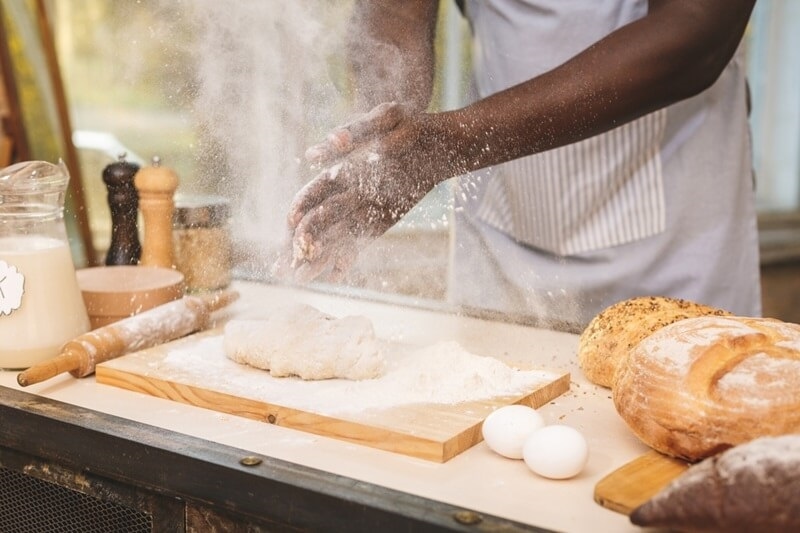African Bread Cooking Tips With Simple Ingredients

Bread has never ever ever just been a food in all of Africa — it is a symbol of heritage, family, and home. From the light-fermented ott and crunchy pan-fried ott, African breads reflect their home continent's diversity. The best part? Most are easily made right in your own U.S. kitchen with simple pantry ingredients.
This blog brings together authentic African bread cooking tips and step-by-step methods for beginners. If you’ve been looking for how to cook chapati African style, searching for practical injera bread cooking tips, exploring new flatbread recipes from Africa, or just wanting a reliable African bread making guide to try easy African breads at home, you’ll find it all here.
Core African Bread Cooking Tips
Before we move into individual breads, let's cover some generic African bread cooking techniques that you'll apply to all the recipes in this book:
- Use fresh ingredients. Dried-out flour or stale yeast can ruin texture and flavor.
- Let the dough rest. Whether you're making a speedy flatbread or a yeasted bread, resting makes the dough softer and more manageable to roll.
- Fry on medium heat. Too hot, and the outside is browned before the inside has a chance to cook. Medium temperatures ensure that everything is cooked.
- Serve fresh and warm. African breads will be at their best quality on the day you bake them.
- Wrap the cooked breads. Roll them up in a towel so that they stay soft while you make the next batch.
Following the above guide for African breads as your guide, we will now talk about actual breads you can try.

How to Cook Chapati African Style?
Chapati or chapo is a staple bread of Eastern Africa. It is light and slightly chewy and great for scooping stews or curries. Learning how to cook chapo African style is a great method for learning about African breads for a beginner.
Ingredients
- 3 cups all-purpose flour
- 1 teaspoon salt
- 2 tablespoons vegetable oil (plus some for frying)
- 1 to 1¼ cups warm water
Step-by-Step Recipe
- In a large bowl, put flour and salt.
- Add gradually warm water and oil and mix with a hand or a spoon.
- Knead 8–10 minutes until smooth and elastic.
- Cover and rest at room temperature for 30 minutes.
- Cut into eight equal-sized balls.
- Roll each ball into a thin circle on a floured surface.
- Heat a skillet over medium heat.
- Cook chapo one at a time, lightly brush with oil, and turn when bubbles show.
- Keep cooked chapos wrapped in a clean towel.
These steps capture the essence of the process of how to cook chapo African style — quick, simple, and deeply satisfying. With practice, you’ll get beautifully soft and flaky chapos every time.
Injera Bread Cooking Tips
Injera bread is the national bread. It's spongy and sour and acts as a plate and spoon to serve up stews such as. It can look like a challenge to cook it, but these tips for cooking injera bread make it simple for a home kitchen.
Ingredients
- 2 cups flour (or 1 cup teff + 1 cup all-purpose flour if teff proves hard to track down)
- 2½ cups water
- ½ teaspoon salt
- Splash of starter (optional, accelerates fermentation)
Step-by-Step Recipe
- Mix the flour and water in a big bowl until smooth.
- Loosely cover and let sit at room temperature to ferment 2–3 days until bubbly and slightly sour.
- Add salt just before serving.
- Heat a non-stick pan over medium heat.
- Pour enough batter into the pan to thinly coat the bottom of the pan.
- Cover and cook without flipping until the top surface is set and small holes are shown.
- Slide the injera off onto a towel to cool. Repeat.
These cooking tips for injera bread guarantee you get the characteristic sponge consistency and sour taste. The tricks are patience during fermentation and gentle heat during frying.
Flatbread Recipes from Africa
Besides injera and chapo, Africa is full of delicious flatbreads that only require minutes to prepare in a pan. Learning African flatbread recipes is a simple way of bringing diversity into your life without spending much time in the kitchen.
Msemen
Ingredients:
- 3 cups all-purpose flour
- 1 cup fine semolina
- 1½ teaspoons salt
- 2 tablespoons oil
- 1¼ cups warm water
Recipe:
- Combine all ingredients and knead to a smooth dough.
- Stand for 45 minutes.
- Roll out to thin rounds, ½ inch thick.
- Fold and roll into squares, oil between rolls.
- Pan-fry in a hot skillet until puffed and golden.
2. Pita
Ingredients:
- 3 cups flour
- 1 tablespoon sugar
- 1 teaspoon salt
- 2 teaspoons instant yeast
- 1¼ cups warm water
- 2 tablespoons olive oil
Recipe:
- Combine all ingredients and knead until smooth.
- Cover and let rise 1 hour.
- Cut into six balls and roll out to thin rounds.
- Cook in a hot skillet until puffed and golden.
3. Mandazi
Ingredients:
- 2 all-purpose flour cups
- 1 teaspoon salt
- 1 tablespoon sugar
- 1½ milk or water cups
- 2 eggs
- Oil for frying
Recipe:
- Whisk all ingredients into a thin batter.
- Heat oil in a pan over medium heat.
- Pour in the batter like a pancake and cook until golden on both sides.
- Serve with honey or eggs.
All of these African flatbread recipes rely on simple ingredients and simple methods. They're perfect for a weeknight dinner and are incredibly hot from the pan.
African Bread Making Guide (Step-by-Step Version)
Would you rather move far beyond the individual recipes? This is an easy African bread-making guide to use for any bread:
- Choose your base flour. All-purpose is fine, but use the teff, millet, sorghum, or whole wheat.
- Mix your dough. Use only enough water to keep the dough together. Add the salt and oil if the recipe requires.
- Knead lightly. Do not over-knead; knead just until smooth. Over-kneading makes bread hard.
- Rest. Let the dough rest for 30 minutes (flatbreads), or let the yeasted bread rise for 1–2 hours.
- Cook on medium heat. A cast-iron or nonstick skillet is best for heat distribution.
- Keep covered. Layer breads in a towel as they are removed from the pan to retain warmth and freshness.
This African bread-making guide allows you to grasp the rhythm of bread making — mix, rest, cook, cover — so you can whip up any recipe with ease.
Easy African Breads at Home
When you're short on time or new to bread making, try making these three simple African breads in the comfort of your own home, which come together in a flash and require no special ingredients:
1. Mini Loaves
Ingredients:
- 3 cups bread flour
- 2 teaspoons instant yeast
- ¼ cup sugar
- 1 teaspoon salt
- 2 tablespoons butter
- 1¼ cups warm milk
Recipe:
- Mix dry ingredients, and incorporate milk and butter.
- Beat smooth, 10 minutes.
- Cover and allow to rise until doubled (about 1 hour).
- Shape small loaves and place in greased pans.
- Bake at 350°F for 20–25 minutes until golden.
2. African Milk Bread
Ingredients:
- 2 cups flour
- ? cup sugar
- 1 teaspoon baking powder
- ½ teaspoon cardamom
- ¾ cup coconut milk
- Oil for frying
Recipe:
- Mix dry ingredients together, then add to the coconut milk to form dough.
- Roll and cut into a triangle form.
- Fry in medium-hot oil until puffed and golden.
- Drain on paper towels.
3. Skillet Bread
Ingredients:
- 3 cups flour
- 2 teaspoons baking powder
- 1 teaspoon salt
- 1 cup plain yogurt
- ¼ cup warm water
Recipe
- Mix ingredients and lightly knead.
- Let it rest for 20 minutes.
- Cut into six balls and roll them thick.
- Fry on a hot skillet 2–3 minutes per side until golden.
All three of these are ideal, simple African breadsthat are homemade: little prep, short cooking time, and rich flavor. They show how versatile African breads can be even with pantry staples.
Conclusion
Exploring African breads can feel like a culinary adventure, but with the right approach, it’s surprisingly simple. By starting with core African bread cooking tips, practicing how to cook chapo African style, applying straightforward injera bread cooking tips, and trying new flatbread recipes from Africa, you’ll quickly get comfortable with the process.
Stick to the step-by-step method of this African bread recipe whenever you try something new, and learn to build confidence by making a few basic African breads at home first. No time at all, your kitchen will be filled with the intoxicating aroma of freshly baked bread — and every bite will have you transported back to the warmth and traditions of Africa.
This content was created by AI

